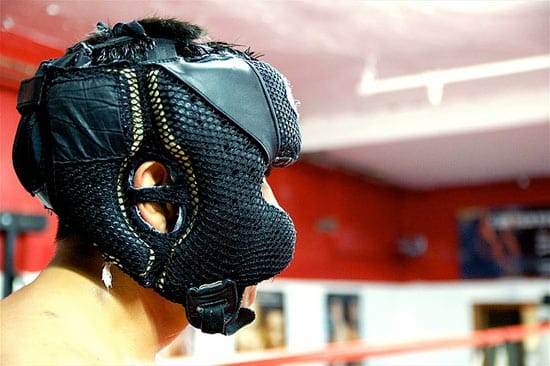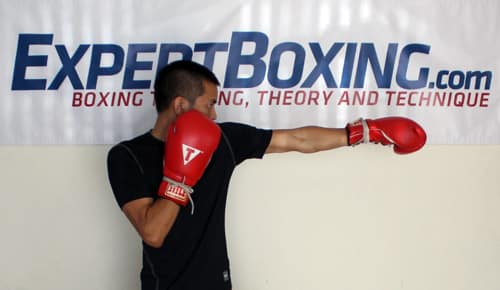
How do you make an opponent expose himself? How do you out-box a faster or better skilled fighter. How do you keep an opponent in constant worry about your next move?
Yes, the answer is by using a feint! But a feint is more than just flicking your glove and pretending to do something. It’s about understanding the essence of movement and understanding WHY your opponent falls for your every movement.
I present to you the 5 CLASSIC BOXING FEINTS!
What is a Feint?
feint – a deceptive blow or movement during a fight
A feint is a movement with deceptive intention. It’s when you show your opponent an intention to do something, but then you do something else.
Examples of feints:
- pretending to punch but then not doing it
- pretending to hit the body but then going for the head instead
- pretending to move in one direction but then going the other
The benefits of using feints in a fight:
- creates vulnerabilities in your opponent
- helps you control the fight psychologically
- can help you defeat faster or more skilled opponents
Below I provide several examples of the 5 most common boxing feints!
FEINT #1) Punch at the Air
Many opponents will defend wherever you punch.
Punching at the air is so effective because of that one simple fact. If you punch at their head, they will defend their head. If you punch at their body, they will defend their body. And so the trick is to punch the air in front of them or to the side of their head or body in hopes of drawing their hand out to the side which then exposes them for your real attack.
Classic punch feints:
- fake a jab to make him extend his hand towards you, then follow with a hard cross or hook.
- jab at the air on the side of his head to make him draw his hand glove to the side, then send in your right cross
- quickly wave your left glove out to the side to make him open up his body, then drive a sharp left hand to his head or body
- quickly lift your right hand as if you’re going to throw a right cross, then quickly attack with a fast jab
FEINT #2) Punch at the Body
One of the best ways to target the head or the body is to attack the other one first. A great tactic is to throw or fake punches to the body and then quickly follow up with punches to the head. The concept is simple the execution is not. There is ONE KEY DETAIL:
The tip to distracting your opponent with body punches
is to watch his eyes!
So many fighters miss this simple tip. It doesn’t matter if your opponent blocks your body shot or not. Watch his eyes carefully when you throw or feint the body shot. If you see in his eyes that he was distracted for a split second, you can capitalize with a big right cross to his head! Pay attention to him carefully!
LITTLE TIP: When you throw a jab to the body, aim more towards his back elbow rather than the front elbow. This will make him flinch or crouch a bit more towards the back and cause him to react more.
Classic body feints:
- throw a jab to the body, right cross to the head
- throw a fast 1-2 to the body, big left hook to the head
- throw a jab to the body, then left hook to the head (ADVANCED)
FEINT #3) Manipulate His Defense
When a feint doesn’t work,
you can use a fast minimally-committed punch.
As you have learned earlier, your opponent will defend where you punch. If feinting punches does not work, you can still get him to react by throwing actual punches. The trick is to throw light and fast punches, thus saving your power for when he is actually vulnerable.
This trick is not only to confuse him between protecting his head and body. You can force him to cover different angles of his head/body therefore exposing him to your other punches. Remember that all punches typically come from 3 different angles: either straight (jab/cross), around (hook/overhand), or under (uppercut). By attacking at one angle, you can force him to concentrate his guard to one side so that your follow up can penetrate through a different angle. But remember, he only moves his guard over if you actually punch.
Classic defense manipulations:
- throw several straight punches into your opponent, and then one BIG HOOK
- throw several fast uppercuts, and then one BIG HOOK
- throw a quick hook (to bring his glove to the side), and then a big straight punch
FEINT #4) Foot Feint
Using the feet is another popular way to take your opponent off guard and even off balance. Many skilled fighters are very good at reading your entire body. They will not respond to a simple arm movement if they see that your whole body is not committed behind the entire movement. Other opponents are too busy being aggressive and following you around that they do not notice or do not care for your arm fakes. In these situations, foot feints can be far more effective.
Against aggressive or skillful opponents,
foot feints can be more effective.
Against a pressure fighter, you can keep changing directions using in-and-out type of movement to keep him off balance. Go one direction and then the other. Against a more skillful opponent, you can quickly step your front foot as if to go forwards to force him backwards or commit to a counter punch.
Classic foot feints:
- fake a step forward, see if your opponent moves back (gives you free ground or psychological control) or throws a counter (leaving himself open)
- step out to your side, but then immediately turn back with a hard counter
- move laterally one way but then change directions (OPTIONAL – throw a counter when you change directions)
FEINT #5) Sharp Exhale
At the most skillful levels of feinting, only the smallest movements are required. Instead of faking an entire punch you can twitch your glove as if it’s going to punch. Instead of moving forward, you can quickly tilt your head down as if you’re going forward. It’s not only the preferred method of feinting because it’s so effective but because it doesn’t leave you vulnerable. In every movement, lies the essence of that movement.
You can fake any movement,
by executing only the essence of that movement.
In this example of feints, I chose to use the sharp exhalation as my feint (that quick *SSHH* noise you make when throwing a punch). The sharp breath sound is so effective is because breathing is a common pre-cursor to many movements. Close your eyes in the gym and you can almost tell who is trying harder based on the sound of his breath. The sound of your breathing always gives away your amount of commitment to a movement therefore making a fantastic feint.
Classic breathing feints:
- when your opponent gets closer, make a quick exhale to back him off (great for defensive purpose but make sure you follow up with real punches every now and then or else he won’t fall for it)
- corner a defensive opponent, make a sharp exhale to make him defend in panic then counter hard around it
- make a sharp exhale, then throw punch not long after (disrupts his rhythm)
The Art of Feinting
There is one rule to feinting!
The golden rule of feinting:
always do something different than expected.
This is perhaps the most important rule of feinting. The goal of feinting is to deceive and any trick no matter how clever becomes useless once your opponent has learned what to expect. This simple understanding can you take you beyond the level of feints. You don’t have to think about how to feint. You can simply throw 1-1-2 twice in a row, and then the third time you throw 1-1-3. If it is different from what is expected, it is a feint!
What’s the difference between a good feint and a bad feint?
It depends on the amount of effort required to produce the desired reaction from your opponent. A lesser-skilled fighter would have to throw a half punch only for an opponent to calmly raise his guard; whereas a skilled fighter only has to twitch his glove to make his opponent react suddenly.
Poor and ineffective feints leave you vulnerable while still not be enough to make your opponent react. Skillful effective feints can make your opponent jump halfway across the ring even with the tiniest of movement. It all comes down to your ability to read your opponent. A master boxer can see where his opponent is most sensitive. If you feel your opponent likes to preserve distance, perhaps you can pretend to move forward. If you feel your opponent is afraid of right hands, perhaps you can pretend to throw more right hands. Whatever the case may be, you have to find out what your opponent is most fearful of!
Some fighters are even more adept at seeing through feints than you think. In this case, only the sharpest and most subtle movements will work to produce a reaction. If you feel you have lulled him to sleep by not responding to you, perhaps you can try creeping into positions. Maybe subtly cock your glove into punching position or creep your feet closer into range. If he’s not going to respond, you might as well take advantage by constantly re-positioning yourself at an advantage.
The art of feinting is all about
making your opponent commit more than you do.
The less you commit, the less opportunity you give him to counter you. The more he commits, the more you have something to take advantage of. In the rare occurrence that you find an opponent who is immune to feints (i.e. is a brawler with no fear), then you do not need feints. Simple counter-punching will do. Feints are best used for opponents who think more than they punch.











Great article man! Feints and mind-games are what will give you an edge against anyone of any skill. A few feints and tricks in any sport or competition is brutal, let alone in boxing. Thanks for the in-depth article!
Nice article! Really helpfull to have a breakdown like this.
I noticed feints work great after you ‘program’ your opponent. Throw the same combinations repeatedly (effective combo’s, don’t sacrifice good boxing for trickery), and after he starts catching on, you fake the last punch and hammer him from a different angle.
can you do a quicky on reach? (finding reach and maintaining reach)
I can do it right now.
Find your reach by practicing on the heavy bag.
Dynamite stuff. So amazing to watch high level fighters getting huge paydays using your exact methods just 2 throw a sometimes better fighter way off his game. The sweetest science at its best! NICE!
how can i faint my opponent off guard to land a body shot?
Make him throw a punch then throw one at his exposed body.
good stuff johnny i like the exhaling feint.
which of the 5 feints toward george foreman (an example is against ali)?
I don’t understand your question.
I think one of the best feints (which you kind of mentioned with #2) is done with your eyes. look at the opponents body and hit him in the head. obviously you gotta be really quick with it, as momentarily you arent looking where you should be, but it works a treat. i reckon the use of your eyes to trick your opponent is possibly worth an article in itself Johnny. just as an idea
Yes, this is a common trick. Look away or look at something else and then fire your counter. It would definitely make for a great article. Many guys have clever use of the eyes when fighting.
i dont agree with the eyes johnny you taught me to look straight ahead and that has benefited me crucially, but my question is if im going against someone who does similar as looking at one big object, does that cancel the feinting with the eyes out? i absolutely enjoy your examples of set ups, they are definitely something to build off of i stated my question with intent to clear up the confusion
Yes, it can.
another superb article and video to go along with it. well this one is timely because recently ive seen pacquiao vs marquez 4, and by the looks of it by the 6th round, pacquiao didint do well in feints. he feints the jab, instead of doing it in his advantage, it back fired on him. because marquez landed an overhand right to him, instead it seems like mr.marquez countered his feint, if what i am thinking is correct.
Don
I believe Marquez capitalized on the pacquiao feint, he understood and with 3 previous fight Marquez was the smarter boxer to adapt to the opposing style. He simply read pacquiao he learned that feint and knew nothing was coming after the initial movement. Thats the split second that marquez took away from pacquiaos night. Pacquiao had been tormenting marquez with those kinda feints in the previous fights. I think feints are a great tool to add to any fine boxer.
Again Great article Johny
Sir Id like to comment on this, very informative info.
“Poor and ineffective feints leave you vulnerable while still not be enough to make your opponent react. Skillful effective feints can make your opponent jump halfway across the ring even with the tiniest of movement”
In pacman vs. marquez 4, I see this during the fight specially in round 6. marquez didnt react to pacmans 2 jab feint, instead he used it as an oppurtunity to land an overhand right.
Expert boxing.com is awesome!
AWSOME!
Hey Johnny love this one but could you possibly write a guide on how to read feints like how to tell if a guy is fakin that would be awesome
Sure thing, Randy. I’ll have to write that one day.
Thank you you don’t know how much youre articles helped me
I’ve been using feints a lot more in my spars but can foot feints be a little dangerous at times if you step in and get caught with a right (coming from a southpaw fighter). I say this primarily because of marquez pacquiao 4 when pacman got caught doing a feint. I try not to do the same feints to much because then they might catch on and learn how to counter it.
How can you defend against your opponent that’s using feints against you.
Try feinting him back. Or feinting like you fell for the feint. Or learn his feints.
Really informative. Just purchased a punchball. Your videos
Great and easy to understand. I will be more confident now. Thank you x
Hey Johnny. Enjoyed your 5 feint tips. Is there any video of you sparing?